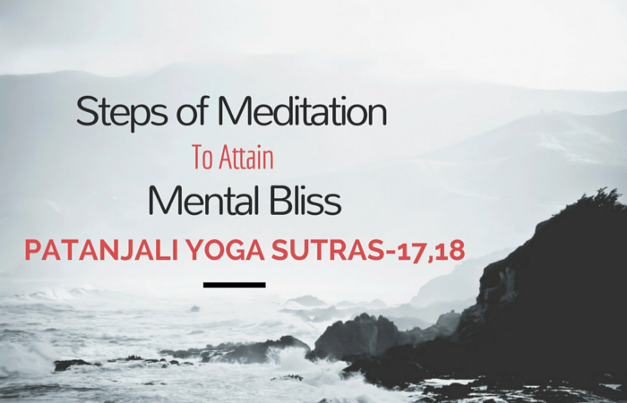In these next two Sutras, Patanjali mentions the different stages on the path to attain mental bliss, following the principles of yoga.
वितर्कविचारानन्दास्मितारूपानुगमात्सम्प्रज्ञातः॥१७॥
Vitarkavicārānandāsmitārūpānugamātsamprajñātaḥ||17||
These Sutras describe concepts and philosophy that is pretty abstract and not easy to grasp. I would suggest the readers to read this post more than once and not try to understand it immediately. These are thoughts that need to be revisited again as one moves ahead on the other sutras. Since what is described here is the stages and not the means to get to them. Further down when one gets to practice actual steps and then experiences these or similar feelings, he can revisit these Sutras to see if it is more meaningful.
To gain proper understanding of these Sutras, one needs to look deep within human psychology, more focused on the self and interactions with man and material on a daily basis. As in any scientific experiment, the process involves observation and inference. Similarly, these yoga sutras entail a series of concentration exercises, in order to observe the thoughts in the mind and understand one’s own psychology. By knowing more and more about the “self”, one can attain mental bliss progressing through different stages of inquiry.
Disturbing thoughts are generated by a combination of 5 kleshas as explained previously. Man being a social animal, he continuously interacts with others and accumulates numerous experiences every day, which gives rise to thoughts and other feelings. Every thought has an experience attached to it. Now here Patanjali is referring to analyzing the experiences that are associated with every vritti that gets generated. One should observe and analyze the varied experiences and past happenings, responsible for generating turbulence.
Taking help from Algebra in mathematics, the value of any unknown object is assumed to be “X”. Similarly, here the nucleus of the mind can be assumed as “X” that lies beyond all the illusory thoughts and ideas. It is the state of pure awareness of one’s being or existence.
In this concentration exercise, the focus should be on the nucleus, in order to see through the thoughts. After this, one should nullify the disturbing elements by concentrating on the self in order to perceive and identify the same. It helps to attain peace and finally achieve introspective vision. This introspective vision helps to become aware of the real self or true nature, which lies beyond the disturbances of mind.
The Concentration exercise has four stages, viz., Examination, Discrimination, Happiness and the Sense of Self. At the core is “X”, which is the clear state of awareness. It helps to perceive the reality directly, without any barrier to vision or illusory thought clouds. This exercise is performed to get rid of various mental characteristics step by step.
In the first stage of Vitarka, the mind argues, analyzes and looks closely at the variables of the disturbing thoughts and opinions about a person or an object, looking more intently and taking a holistic and 360 degree view of the same. The mind analyzes and tries to find answers to questions like:
How important this particular incident is to my life?
What am I losing and what am I gaining in an objective way?
Did the other person involved work hard to deserve better?
Depending upon the situation, these questions vary but the focus is always on finding “X”, just like a problem in Algebra. The examination of the logical mental functions lets one understand the limitations of analytical mind. Things beyond analytical mind become visible and evident, reducing the reactionary habits and anxiety.
That is followed by Vicara, the second stage wherein the thought functions are contemplated and understood threadbare. In this exercise, the whole inner composition of thoughts and their characteristics are grasped and understood. Constant practice of yoga helps to see through the mind and look at it through an invasive camera, as used in surgery. The thoughts behind the thoughts are looked at.
The focus on the object “X” needs to be so intense that one becomes aware of many new manifestations that were previously unknown. Characteristics of Supernatural powers like clairvoyance or occult practices is an ordinary outcome in these stages. Once that is done, then the mind starts looking at the world around with a better vision. It has no more qualms or complaints left at this stage. The practitioner then uses these observations and inference to free himself from the kleshas.
Finally, there is the realization that the variables of disturbing thoughts involved are all finite and temporary. The disturbing thoughts are paused and one realizes that the pain that was being felt, was based on ignorance and was not justified.
The following two phases are of realization. When the analysis and observation is complete, the mind then enters into the third stage called ananda or bliss. The mind attains bliss automatically as soon as it identifies itself as having more than just the cognitive abilities.
The aim here in this concentration exercise is to achieve the divine inward vision or introspective insight. It lies beyond the analytical mind, which is used to function in a logical manner only. Through performing this concentration exercise, it is understood that one can unfold the higher levels of mind that exist above the intellectual abilities.
In state of ananda, since the equation has been solved, one can better utilize his intellect and omnipresent nature of the mind to give peace and not pain to his existence. As this stage, one starts using the super natural powers that mind has inherent in it and not just the logical operations and analysis. The default settings get adjusted inside the mind to stay in the state of bliss effortlessly.
The next and final stage in this concentration exercise is asmita where one unites himself with the object “X”. After gaining control over the mental fluctuations and realizing the illusory nature of thoughts, the ignorance is removed. This process automatically results in bliss as one reaches the higher level of awareness. As a result, the inward vision develops and becomes clear.
As soon as the introspective vision is developed, one can directly look into the core of the mind, which is the object of concentration. At this stage, one realizes that the object “X” is no different from the self. It is unchanging and permanent, as opposed to the thoughts and opinions that are transitory and based on limited understanding. The object “X” is nothing but the awareness of the existence of self as pure bliss. It is beyond all the confusions created by ignorant mental states and can only be attained after getting rid of ignorance. Thus, it is clear that asmita or the awareness of the self is attained by performing this concentration exercise.
विरामप्रत्ययाभ्यासपूर्वः संस्कारशेषोऽन्यः॥१८॥
Virāmapratyayābhyāsapūrvaḥ saṁskāraśeṣo’nyaḥ||18||
Prominent French Psychologist Pierre Janet said “Underneath the layers of critical-thought functions of the conscious mind, lies a powerful awareness that is the subconscious mind”.
Now that the thought disturbances have been brought under control through analyzing and overcoming the conscious mental functions, the practitioner can maintain a blissful state of mind, irrespective of the happenings around him.
This sutra takes a peep into the previous births and the thoughts and experiences gained then, which are deeply embedded in an individual. As per Vedanta Philosophy, man goes through a series of births. After having gained control over the interactions happening in this birth, one needs to remove the illusions and kleshas carried from the previous births.
Explaining it concisely, there are certain traits which are inborn. The fear of death is something one carries from previous birth. So certain potent subdued traits are embedded in every human being by birth. Say an Orange tree seed can be kept for ages but will always grow into an orange tree and not any other fruit tree. These inborn traits are called as Samskaras that define one’s nature.
Using Yogic steps of concentration an individual is required to burn these traits. The seed should get burnt and lose its potency so that it can no longer grow into an orange tree. Then one is free from both the kleshas of this life as well the carried forward kleshas of previous lives.
Some of these samskaras have been accumulated by the individual in the previous births and are the source of all his inherent characteristics. They condition his mind to behave in a particular way, depending upon the type of experiences he has had. As a result, he lives in an illusion created by his past experiences, which limits his scope of awareness and understanding. Behind the clouds of these samskaras lies the real nature of every human being, which is a blissful state of expanded consciousness, free from yearning and pain.
The seed that is being discussed here, has its seat in the subconscious. This seed incessantly gives rise to more and more actions and these actions in turn create new samskaras and this cycle goes on. Vedas mention that after death, one is reborn based on his desires and attachments (samskaras). Thus, until the samskaras have been successfully uprooted, the mind will continue to act according to the intrinsic qualities.
So it is clear that the perception and understanding of an individual are largely distorted by his samskaras that are based on irrelevant past experiences. Samskaras do not have their roots in the reality but are based on impressions of temporary mental state of that time. Thus, in order to release the mind from chains of accumulated information and learned behavior, one needs to return to the state of innocence where mind is free from any knowledge or information.
Once the samskaras have been uprooted and the seed has lost its potency to give rise to further disturbances, the mind is established in its natural state of bliss and attains rest. The seed of ignorance has been burnt and one is able to perceive himself as a part as well as the whole of the existence.
As mentioned in the beginning of the article, these sutras are pretty conceptual which is difficult for a normal logical person to comprehend. That is the reason it took me more than 5 weeks to try and get the message across without it going over the head. Further into sutras, when we learn about the activities which will help us reach these steps, it would be nice to refer and understand the feelings generated as a result of those actions.



